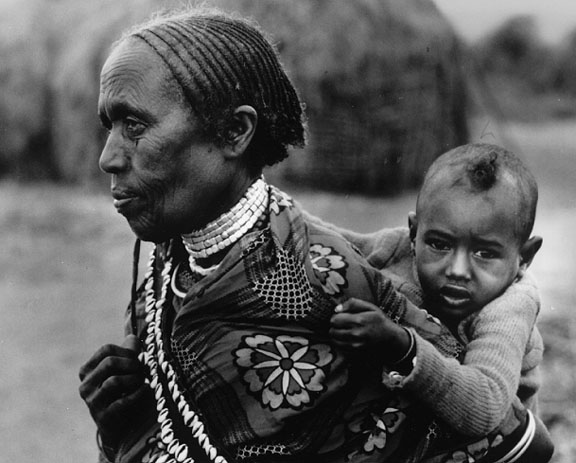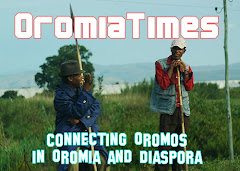Thursday, March 30, 2006
Garissa, Kenya -- One in an Occasional Series
Over the buzz of hospital ceiling fans, Habiba Mohammed heard the slightest murmur emerge from her daughter's wasted chest: The baby was hungry. She pulled down the top of her dress and offered her emaciated child a breast that had not had milk for months.
Her daughter, Hadiwa, is a casualty of a sustained, four-year drought that is threatening the lives of 17 million people across East Africa. Her ankles are no thicker than an adult's thumb; wrinkled skin hangs loosely around her thighs and angular pelvic bones. She is 9 months old and weighs 8 pounds, just over a pound more than her birth weight. Tuberculosis, malaria and pneumonia are eating away at her tiny body.
She could recover, say doctors at Garissa Provincial Hospital, but it will take at least two months of intensive feeding. Mohammed, 19, says she cannot wait that long.
"There are things I need to attend to at home," she said, her eyes fixed on the tiled hospital floor.
After the drought destroyed the pastures and killed off the family's livestock, her husband was forced to go to Garissa to look for work as a day laborer. Now their house of sticks and straw, in the dry bush several miles south of Garissa, remains unattended. If she does not return home soon, someone might steal their sleeping mats and cooking utensils -- and maybe even the house itself, Mohammed said.
It's a cruel dilemma that doctors at the Garissa hospital see repeatedly.
Their families living in abject poverty, children on the brink of starvation who are brought to the Garissa hospital rarely complete their treatment because of social and economic pressures on their mothers, said Dr. Khadija Abdalla, the chief pediatrician at the hospital.
"Often they have to return to their other children, whom they've left in the bush. Sometimes they come with other children, which puts these new children at risk of contracting disease. Husbands also pressurize them to return," said Abdalla. "It's very frustrating, especially when you know that they're going to have to come back."
At least 500,000 Kenyan children face the threat of starvation as the worst drought to hit East Africa in decades enters its fourth year, aid agencies say, and cases of severe malnutrition are on the rise. The drought and subsequent famine stretch across swaths of Kenya, Ethiopia, Eritrea, Somalia, Djibouti and Sudan, countries that are simply not prepared to deal with the looming humanitarian crisis, say international aid officials.
The Garissa hospital is the only medical facility that provides therapeutic feeding to children in Kenya's drought-ravaged North Eastern province of 400,000 people. Twenty children diagnosed with severe malnutrition are currently receiving treatment, 10 times the usual number, said Abdalla. Since December, seven children admitted to the hospital have died.
The real number of children suffering and dying without being seen by doctors is probably much higher, she said.
As it is, the hospital is barely able to cope with the number of patients it has. The pediatric ward, meant to treat a maximum of 50 children, had 56 patients Monday. As the effects of the famine intensify, those numbers, too, are likely to increase dramatically, say medical workers. The nurses -- just two per shift -- can do little more than weigh the children and deliver medicine. This means mothers must stay with their sick children day and night. But many of these mothers -- some of whom have just reached adolescence themselves -- don't make the best caregivers, Abdalla said.
"Most mothers are illiterate. You can't instruct them," she said. "Sometimes the children get four or five (therapeutic) feeds a day instead of the nine that are required."
Many mothers don't have the money to pay for their children's treatment, like Ladhah Abdulla, 20, the mother of Malyun Osman, a skeletal 2-year-old girl weighing 12.7 pounds.
Her husband left for South Africa two years ago when Abdulla was still pregnant with Malyun. The husband said he would look for work there and send money home, but so far, no money and no word have come from him. Abdulla, who also has a 5-year-old son, Faisul, moved in with her parents, impoverished herders who themselves barely have the means to get by.
So far, the hospital has waived the costs of Malyun's treatment -- the equivalent of 70 cents per day. But Abdulla does not know how long this benevolence will last. Doctors say Malyun, who spends her days playing with breadcrumbs in a beat-up aluminum bowl on her cot by a window covered with anti-mosquito netting, will need six months to recover.
"I'm not sure how long I will stay here," Abdulla said. "I can't afford to pay for the bed."
Four cots away, Batula Guhat faced a similar situation. Two weeks ago, after a 100-mile walk through the bush that took almost two months, Guhat, 53, brought her bird-like granddaughter, Fatuma Hillow, 2, to the hospital. Fatuma weighs less than 10 pounds; her hands are so small that doctors have to inject her anti-tuberculosis medications into her feet. Fatuma's chest protrudes abnormally; last week, her heart stopped temporarily.
After 10 days at the hospital, doctors realized that she needed to go to the capital, Nairobi, to see a cardiologist the Garissa hospital doesn't have.
"The problem is, if you give them an alternative to go to Nairobi, they opt not to because they can't afford it," Abdalla said before she gave Guhat the news.
Guhat considered her options. The hospital would pay for the transportation to Nairobi, but there will be expensive tests and even more expensive treatment, possibly surgery.
"I can't afford to go," Guhat said.
A minute later, Abdalla learned that her other patient, little Hadiwa, also will not receive the full treatment she needs.
"She will gain one more kilo," (2.2 pounds), "and then we'll leave," said Hadiwa's mother as she avoided the doctor's eyes. Seven other mothers, who were listening in the hospital room, where the temperature was above 100 degrees, kept fanning their emaciated children with the loose ends of their colorful scarves. Abdalla lifted her eyebrows and pursed her lips. She knew she could not stop Mohammed from leaving any more than she could make it rain and break the devastating drought.
So all she said, as her gaze rested on a banana peel on a wooden stool near Hadiwa's cot, was: "You've made this place a mess. It's unsanitary. You have to keep it clean."
E-mail Anna Badkhen at abadkhen@sfchronicle.com.




















No comments:
Post a Comment